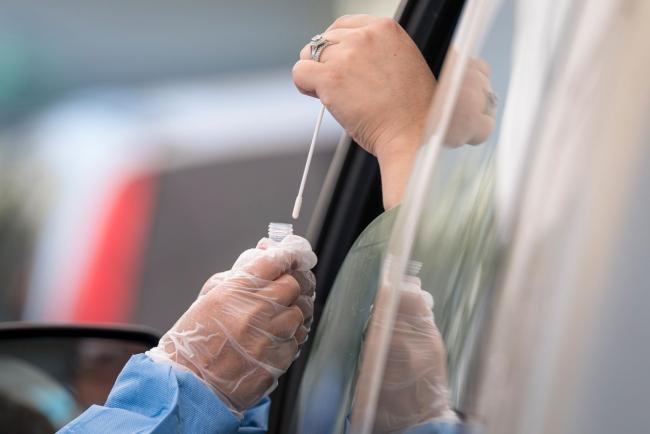(Bloomberg) -- States told the Department of Health and Human Services that they need new machinery, more personnel and more testing supplies in submissions Friday detailing how they plan to build out screening for Covid-19.
The plans highlight the ongoing supply-chain challenges that labs in states with surging case counts face in procuring key supplies like chemicals, rapid diagnostics and protective equipment for personnel, showing how an influx of about $11 billion in funds distributed to states in May may not be enough to solve these persistent problems.
Covid cases are surging across the U.S. and testing capacity has again been a key bottleneck, with test-takers complaining about long lines and waits of a week or more for results, while labs warn of shortages of key supplies. Mass testing is essential to identify positive patients so they can be isolated and their contacts notified of their exposure risk. Delayed results set back those efforts, allowing the virus to continue on a path of explosive spread.
In three states shouldering some of the heaviest caseloads, their testing woes demonstrate that while testing has improved since the virus’s early days, U.S. capacity remains severely strained.
In Florida, which is witnessing record deaths and hospitalizations, the health department planned to invest in more diagnostic testing equipment, but at the time of the filing was still awaiting delivery of many items. Filings were due May 30 and underwent federal review in June.
Texas, Arizona
Texas’s submission describes how such machinery can make a major difference for a lab. One new platform in Laredo, for instance, “will increase testing capacity there by 50%,” while new equipment for Lubbock and Tyler labs “will increase testing throughput from 100 per day to 650 per day and from 50 per day to 500 per day, respectively.”
Key testing chemicals called reagents had become easier to access, but what’s available doesn’t always work on the equipment that labs have, the state said.
In Arizona, where a surge has filled hospital intensive-care units with Covid patients, facilities don’t have enough rapid tests for patients, which they say is “hampering their ability to most effectively triage patients” and maximize protective equipment for providers, according to its plan. Arizona is working with the federal government to use machinery already in state labs more effectively, including by getting “test kits which are in short supply and backordered.”
“At this time, the supply of collection materials and testing supplies are adequate to meet current response efforts in Arizona,” Arizona’s HHS submission said. But “the current supply of materials, particularly swabs, is anticipated to be insufficient for the fall and winter season, due to the need for concurrent influenza and Covid-19 testing.” The state health department is looking at ways to manufacture swabs and evaluate other types of swabs and preservatives.
States set their own testing targets in partnership with the federal government, and in the submissions were required to detail the number of tests needed, estimates of laboratory and testing capacity and how they’ll use the resources.
Shifting Needs
The $11 billion was distributed according to a formula that reflected the burden of Covid-19 as well as population-based estimates, officials said in May. But the brunt of the pandemic has shifted significantly since then, from the northeast to Sun Belt states, raising questions about whether additional funding may be required.
New York received about $750 million, more than any other state, and New York City got roughly $850 million. New Jersey got $650 million, California about $600 million, Los Angeles County nearly $337 million, Massachusetts about $400 million and Texas nearly $568 million.
The shortfalls in U.S. testing highlight the Trump administration’s failure to execute a cohesive national strategy, even as the country reopened and Americans increasingly going back to work, eating out and gathering socially clamored for the screenings.
The burden instead shifted to states, which were provided over 36 million swabs and 27 million tubes of transport media in the last two months, according to Assistant Secretary for Health Brett Giroir’s office, but have continued to face supply limitations. The Trump administration is now ramping up screenings in Louisiana, Texas and Florida through temporary sites offering free tests as part of an effort to “assist local leadership to reduce community spread,” Giroir said in a statement.
©2020 Bloomberg L.P.
